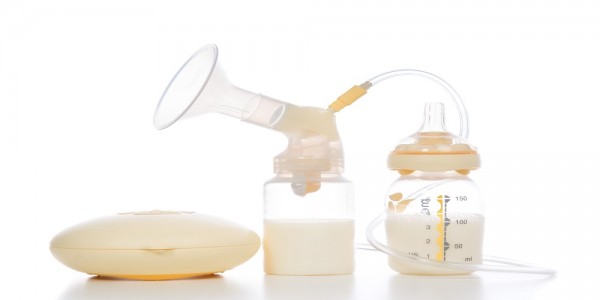There are two nursing supplementers available in the United States which are intended for use by adoptive mothers: the Lact-Aid Nursing Trainer and the Medela Supplemental Nursing System (SNS).
Medela’s Starter SNS was designed for short-term use and will not hold up to the repeated use required for adoptive nursing. In my experience, it does not work very well even when it does hold up. If someone needs to get by for a while with a device available in a hospital, the Medela Finger Feeder would be far more useful than the Starter SNS.
In a pinch, a temporary supplementer can be made by inserting a tubing through the hole of a bottle nipple. The tubing should be long enough for one end to hang to the bottom of the bottle and the other to reach the mother’s nipple. If one of the tall, narrow, plastic bottles from ready to feed formula is used, the mother may be able to just tuck it into her bra.
Some moms who use the SNS have found that the tubing to the device can break off. This tube would be fine for inserting through a bottle. A gavage feeding tube can be used for this, if it is the only thing available, but it would be obvious to the baby and probably rub a raw spot on the breast quite quickly. Anyone using this would want to find a Lact-Aid or SNS as soon as possible.
Many adoptive moms get their information from La Leche League (LLL) and, since LLL sells the Medela SNS, are told about it (and sold one) without having a chance to see the Lact-Aid. Some moms make it with the SNS, but many more find nursing to be too much of an ordeal with it. Many adoptive nursing situations have been preserved by a last-minute switch to the Lact-Aid.
Of the two, the Lact-Aid is highly preferred over the Medela SNS by adoptive mothers who have had a reasonable amount of experience with both (yours truly included!). Among the features that make the Lact-Aid more convenient for adoptive mothers, most of whom must use it many times a day for many months, are that the Lact-Aid is:
— much easier and faster to put on and get set up to nurse (which is important when there is a baby screaming to be fed!)
–much easier to conceal under clothing and use discretely in front of others
–more comfortable to wear
–easier to adequately clean
–easier to use lying down or slumped down in a recliner
–much easier to use without tape, which can cause a great amount of skin damage
–more conducive to proper suckling
The tube is softer, more flexible, and more durable. Some babies who refuse the SNS tube will take the Lact-Aid tube. (They feel about the same to an adult’s fingers, but not to a baby’s mouth). Another problem with the SNS tube is that a baby will sometimes learn to suck in such a manner as to extract milk from the tube, and not be properly expressing the breast. Some of these problems may be helped by using the smallest SNS tube, rather the medium, as is recommended. However, it is much easier to just start out with the Lact-Aid.
Cost wise, the two are similar. A double Lact-Aid kit costs only slightly more than one SNS. Additional disposable bags must be purchased for the Lact-Aid, if it is to be used very long, but, almost invariably, additional units of tubing must purchased for the SNS because they break. Because the Lact-Aid tubing is more durable and flexible, it is very rare for it to break.
Ideally, the adoptive mother should own enough units that she only needs to wash and fill supplementers once or twice a day. She may be able to get by with one, but it is best to have a spare of every piece. Some adoptive mothers have been caught without one of the tiny pieces required to put the unit together, which is not a good discovery to make when there is a baby who needs to be fed!
Copyright © 1999-2000 Darrillyn Starr. All rights reserved. Reproduction in whole or in part without permission is prohibited.

